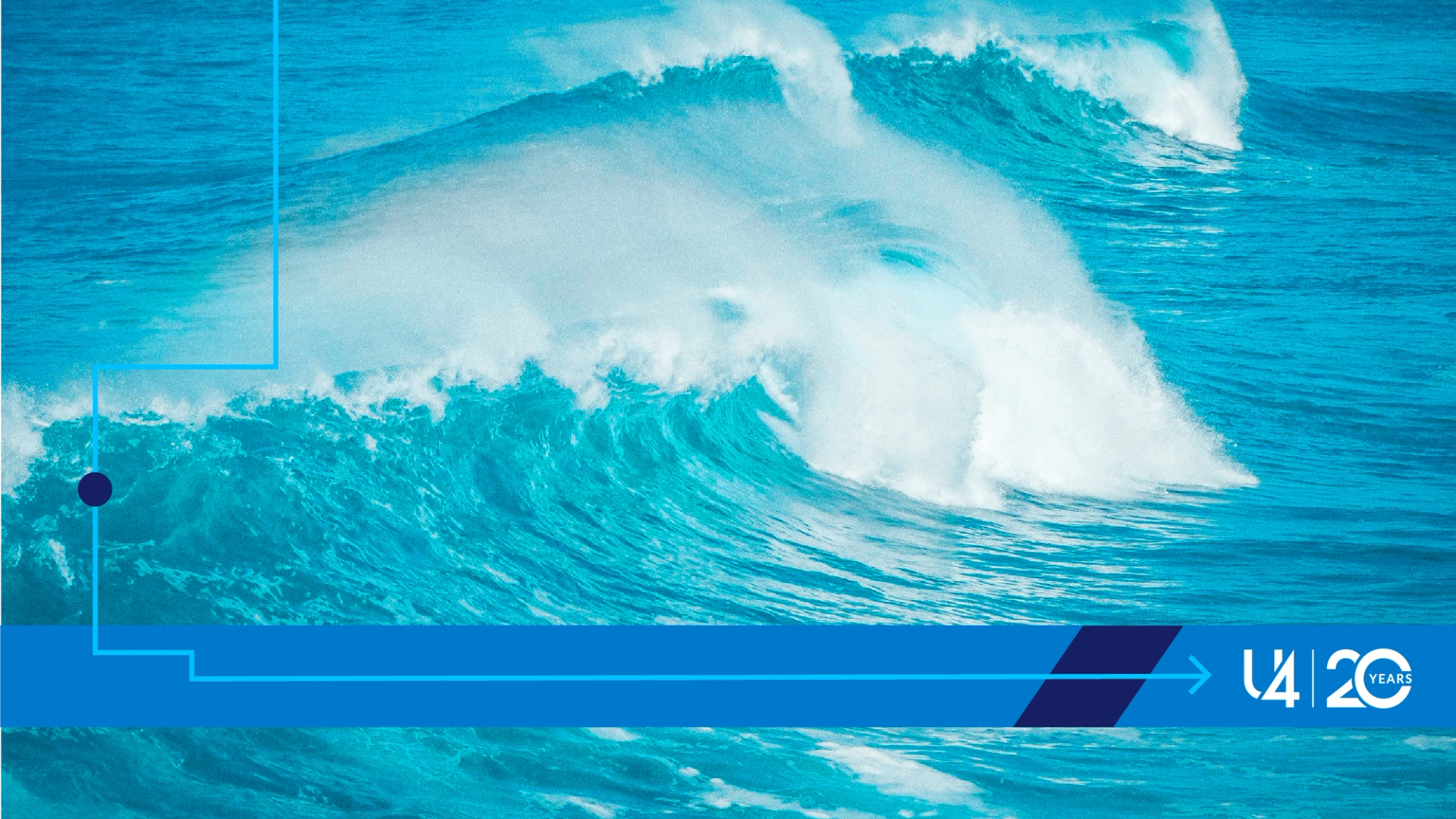Blog
Three waves of (anti-)corruption measurement: The role of civil society in driving innovation and progress

U4 senior adviser Sofie Schütte was in the audience for Johannes Tonn’s presentation, earlier in 2023. Sofie felt his reflections on the past three decades of (anti-)corruption measurement would be the perfect fit for the U4 ‘anniversary’ series, and deserved a wider audience. This blog is Johannes’ write-up of his presentation.
In late summer 2023, I was invited to reflect on the role civil society has played in driving corruption and anti-corruption measurement efforts over the past 30 years at the Global Conference on Harnessing Data for Anti-Corruption – hosted by the International Anti-Corruption Academy (IACA), the United Nations Development Programme (UNDP), the United Nations Office on Drugs and Crime (UNODC), and the Organization for Economic Co-operation and Development (OECD) in Vienna.
The purpose of the meeting was to reflect on the impact anti-corruption measurement has had, and to compare notes between governments, civil society, international organisations, and academia on how to measure corruption more effectively. The conference concluded with the declaration of the Vienna Principles for the measurement of corruption, which informed the resolution on corruption measurement adopted by the Conference of State Parties in Atlanta in December.
The punchline of my musings: civil society has done a tremendous job in innovating and pushing the boundaries of what we dare to measure. It has challenged other stakeholders to be ambitious and to focus always on the purpose of anti-corruption measurement as the yardstick for methodological innovation; measurement is seen as the means, not an end in itself. In doing so, civil society has led the way in shifting the focus of (anti-)corruption measurements and assessments in three distinct waves over the past 30 years, advancing our thinking about how to be yet more effective in the fight against corruption.
1st wave: Measuring corruption (around 1995–2005, but ongoing)
Transparency International’s Corruption Perceptions Index and the World Bank’s Control of Corruption Indicators put corruption on the global radar and paved the way for anti-corruption advocates to make corruption tangible. Though there are important caveats regarding the approach and method of these efforts to ‘measure’ corruption (see for example Paul Heywood’s and Matthew Stephenson’s critiques of the Corruption Perceptions Index), the original undertaking and more refined subsequent iterations have helped the field embrace the idea that while measurement and data matter, we are unlikely to ever measure corruption perfectly – and that this may be ok!
Irrespective of the many limitations any measurement approach must contend with, there is value and need in continuing to assess the extent of corruption. One such example of exciting current work is Yuen Yuen Ang’s Unbundling Corruption Index, which distinguishes between categories of corruption, while still using perception-based data.
2nd wave: Measuring anti-corruption and integrity (around 2004–2014, also ongoing)
In response to the first wave of measurement, questions emerged about how to better disaggregate data between the level of nation states and local jurisdictions, how to differentiate between types of corruption in sectors, and how to account for discrepancies between codified laws and everyday lived practice. Above all, anti-corruption advocates increasingly recognised the potential of actionable indicators to help governments and civil society figure out which anti-corruption measures to prioritise. The Global Integrity Report and Integrity Action’s Fix-Rate are trailblazing examples of civil society constructing measures to inform and support steps to deter, prevent, and combat corruption.
While the initial excitement about actionable indicators has long since given way to a more nuanced understanding of the complexity involved in fighting corruption successfully, meaningful work continues to be produced. One outstanding example is the OECD’s effort to supercharge the mapping of public integrity indicators among its member states at a level of granularity and actionability that was previously unheard of.
3rd wave: Assessing anti-corruption ecosystems (around 2011 to today, and ongoing)
Reflecting on the limited progress that the first and second waves of anti-corruption measurement have achieved has helped anti-corruption stakeholders to flesh out new thinking about how to effectively push anti-corruption reforms. It has also helped them to acknowledge the dangers of isomorphic mimicry – in which organisations simply copy interventions and policies from one context to another without regard to genuine results. With these considerations in mind, civil society’s focus once again shifted – this time toward assessing its own positioning and actions as a contributing force in an ever-evolving ecosystem of anti-corruption actors intent on driving progress towards more effective anti-corruption solutions. An important innovation in this third wave is the increased focus on the use of monitoring, evaluation and learning (MEL) techniques to understand and assess the utility of actions taken, outcomes elicited, and impact achieved.
In 2021, the Transparency and Accountability Initiative assessed the ecosystem of beneficial ownership transparency reform over the past 10 years. It examined the evolution of standards, the implementation of reform projects, and contributions made by funders, civil society, and governments to tease out how different contributions have led to progress. A key finding was that a rich ecosystem with purposeful and coordinated action among different actors led to good progress on beneficial ownership reform.
The Open Government Partnership (OGP) – through its Independent Reporting Mechanism – has been tracking the ambition, implementation, and results of OGP commitments made by its members since 2011, providing opportunity for input and review by both governments and civil society. In addition to country-specific reports (similar but different from other peer review mechanisms in the international arena), the OGP also produces reports on key challenges identified and makes connections between the work that different stakeholders can contribute to implementing anti-corruption reforms.
Takeaways: The importance of measurement
My key takeaway is that measurement attempts have been important not just as a means to understand the prevalence of corruption (wave 1), the utility of anti-corruption institutions or mechanisms to counter it (wave 2), or the ability of an ecosystem to work together productively (wave 3). Beyond that, the shifting focus in the field of measurement – led and propelled by civil society – is a reflection of the evolution of the anti-corruption field itself.
For some time now, there has been increased recognition among anti-corruption practitioners, experts, and scholars that while technical barriers exist, and while capacity and resource questions need to be addressed, the key question appears to be whether, and to what extent, stakeholders in the anti-corruption field are able to craft, nourish, and nurture the coalitions that are essential to create and sustain the political will necessary to fight corruption.
Better understanding how we locate and situate organisations’ efforts to tackle corruption within a constantly evolving ecosystem of actors – made up of governments, civil society, private sector, academia, and social movements – is the key to generating the political will necessary to make progress in the fight against corruption. And the third wave of measurement is helping us to do exactly that.
Anniversary blog series
U4 staff and friends celebrate U4’s 20th anniversary with a blog series reflecting on developments and lessons learned in a world of ever evolving corruption challenges:
- U4 at 20: A quiet birthday at home with friends (across the world) – Peter Evans
- Specialised anti-corruption institutions: Measuring their performance and managing our expectations – Sofie Schütte
- The role of technology in anti-corruption: Dystopian reflections – Daniel Sejerøe Hausenkamph
- Strategic litigation and its untapped potential for anti-corruption – Sophie Lemaître
- The anti-corruption community should become more ‘tribal’ – David Jackson
- Corruption risk management in the aid sector: past, present, and the path ahead – Guillaume Nicaise
- Corruption is unaffordable for Latin America’s resurgent left: Democracy and lives are at stake – Aled Williams and Daniela Cepada Cuadrado
- Corruption is absent from the UN ‘World of Debt’ report – Daniela Cepada Cuadrado
- Anti-corruption games: Learning how to face corruption challenges – Guillaume Nicaise and Rachael Tufft
- a) Gender and corruption: What we’ve learned from 20 years of research (Part 1) – Ortrun Merkle and Ina Kubbe
b) Gender and corruption: Charting the course for the next 20 years (Part 2) – Ortrun Merkle and Ina Kubbe - Three waves of (anti-)corruption measurement: The role of civil society in driving innovation and progress – Johannes Tonn
Sign up to the U4 Newsletter to get updates, or follow us on Twitter | Linkedin | Facebook.
Disclaimer
All views in this text are the author(s)’, and may differ from the U4 partner agencies’ policies.
This work is licenced under a Creative Commons Attribution-NonCommercial-NoDerivatives 4.0 International licence (CC BY-NC-ND 4.0)


